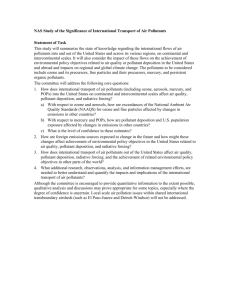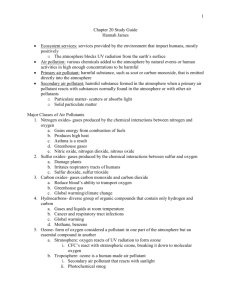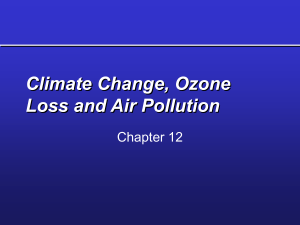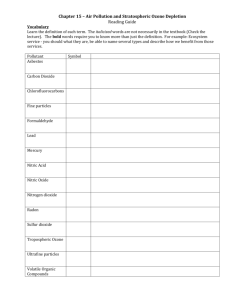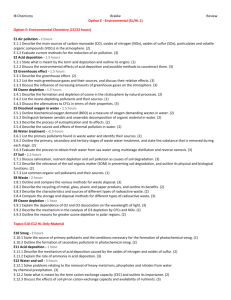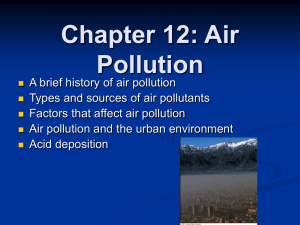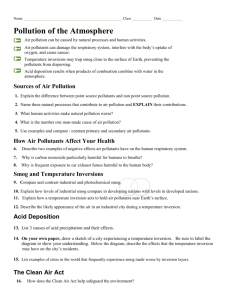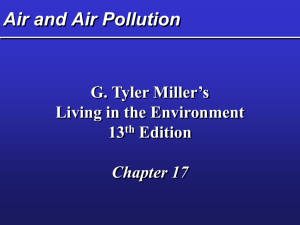Name: AP Environmental Science The Atmosphere and Outdoor Air
advertisement
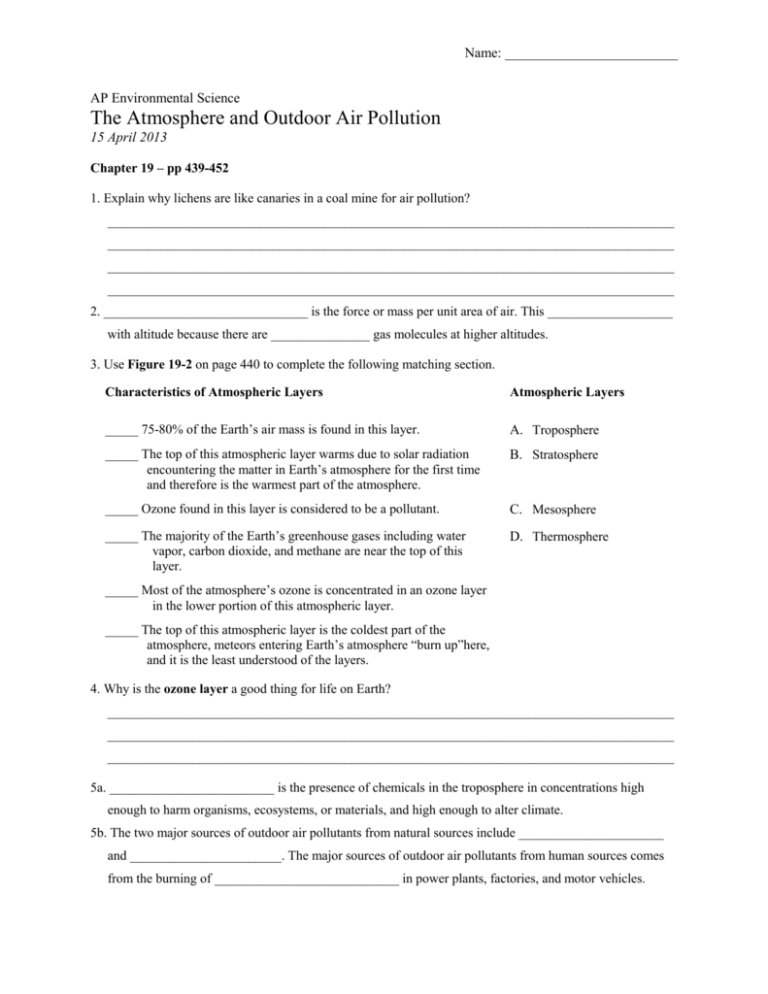
Name: _________________________ AP Environmental Science The Atmosphere and Outdoor Air Pollution 15 April 2013 Chapter 19 – pp 439-452 1. Explain why lichens are like canaries in a coal mine for air pollution? ______________________________________________________________________________________ ______________________________________________________________________________________ ______________________________________________________________________________________ ______________________________________________________________________________________ 2. _______________________________ is the force or mass per unit area of air. This ___________________ with altitude because there are _______________ gas molecules at higher altitudes. 3. Use Figure 19-2 on page 440 to complete the following matching section. Characteristics of Atmospheric Layers Atmospheric Layers _____ 75-80% of the Earth’s air mass is found in this layer. A. Troposphere _____ The top of this atmospheric layer warms due to solar radiation encountering the matter in Earth’s atmosphere for the first time and therefore is the warmest part of the atmosphere. B. Stratosphere _____ Ozone found in this layer is considered to be a pollutant. C. Mesosphere _____ The majority of the Earth’s greenhouse gases including water vapor, carbon dioxide, and methane are near the top of this layer. D. Thermosphere _____ Most of the atmosphere’s ozone is concentrated in an ozone layer in the lower portion of this atmospheric layer. _____ The top of this atmospheric layer is the coldest part of the atmosphere, meteors entering Earth’s atmosphere “burn up”here, and it is the least understood of the layers. 4. Why is the ozone layer a good thing for life on Earth? ______________________________________________________________________________________ ______________________________________________________________________________________ ______________________________________________________________________________________ 5a. _________________________ is the presence of chemicals in the troposphere in concentrations high enough to harm organisms, ecosystems, or materials, and high enough to alter climate. 5b. The two major sources of outdoor air pollutants from natural sources include ______________________ and _______________________. The major sources of outdoor air pollutants from human sources comes from the burning of ____________________________ in power plants, factories, and motor vehicles. 6. What is the difference between a primary air pollutant and a secondary air pollutant? ______________________________________________________________________________________ ______________________________________________________________________________________ ______________________________________________________________________________________ ______________________________________________________________________________________ 7. Match the pollutants in Column B with the statements in Column A. Column A Column B _____ combination of nitrogen oxides and water vapor that contributes to acid deposition A. carbon monoxide _____ colorless, highly reactive gas that is a major component of photochemical smog and which exacerbates a variety of respiratory ailments B. carbon dioxide _____ gases that form when nitrogen and oxygen react at high-combustion temperatures, during lightning storms, or when bacteria create it as part of the biological nitrogen cycle C. nitrogen oxides _____ organic compounds that exist as gases in the troposphere like methane, benzene, and many aerosols D. nitric acid _____ colorless, odorless, highly toxic gas that comes from the incomplete combustion of carbon-containing materials E. sulfur dioxide _____ a variety of solid particles and liquid droplets small and light enough to remain suspended in the air for extended periods F. sulfuric acid _____ two-thirds of this colorless gas with an irritating odor comes from burning coal, refining oil, or smelting ores that contain sulfur G. suspended particulate matter (SPM) _____ a mostly natural greenhouse gas that traps heat in the troposphere which became a regulated pollutant by the EPA in 2011 H. ozone _____ naturally occur colorless, odorless, radioactive gas found in some types of rock I. _____ result of water and sulfur dioxides combining in the troposphere and returning to earth as wet or dry deposition J. radon volatile organic compounds 8. What is industrial smog or gray-air smog? Why is this rarely a problem in developed countries any more? ______________________________________________________________________________________ ______________________________________________________________________________________ ______________________________________________________________________________________ ______________________________________________________________________________________ 9. What is the Asian Brown Cloud? What causes it? ______________________________________________________________________________________ ______________________________________________________________________________________ ______________________________________________________________________________________ 5a. What is e-waste? _______________________________________________________________________ 10a. Air pollution known as __________________________ is a mixture of primary and secondary pollutants formed under the influence of UV radiation from the sun. 10b. Complete the chemical equation for the formation of photochemical smog. _____________ + NOx + ______________ +________________ ground level ____________ + photochemical oxidants + aldehyedes + secondary air pollutants 11. List FIVE factors that help reduce outdoor air pollution. I. ________________________________________________________________________________ II. _______________________________________________________________________________ III._______________________________________________________________________________ IV._______________________________________________________________________________ V. _______________________________________________________________________________ 1.2 Briefly explain how each of the factors below might increase outdoor air pollution. urban buildings:_______________________________________________________________________ ____________________________________________________________________________________ hills and mountains:____________________________________________________________________ _____________________________________________________________________________________ higher temperatures:_____________________________________________________________________ _____________________________________________________________________________________ VOC emissions from certain trees and plants:_________________________________________________ ______________________________________________________________________________________ grasshopper effect:_______________________________________________________________________ ______________________________________________________________________________________ temperature inversions: ___________________________________________________________________ ______________________________________________________________________________________ 13. Describe the two types of weather conditions and surface features that make an area prone to temperature inversions. _____________________________________________________________________________________ _____________________________________________________________________________________ _____________________________________________________________________________________ _____________________________________________________________________________________ _____________________________________________________________________________________ 14a. Describe TWO differences between wet acid deposition and dry acid deposition? ______________________________________________________________________________________ ______________________________________________________________________________________ ______________________________________________________________________________________ 14b. Why is acid deposition a regional problem? ______________________________________________________________________________________ ______________________________________________________________________________________ ______________________________________________________________________________________ 15. Describe FOUR harmful effects of acid deposition. I:____________________________________________________________________________________ _____________________________________________________________________________________ II:___________________________________________________________________________________ _____________________________________________________________________________________ III:___________________________________________________________________________________ ______________________________________________________________________________________ IV:___________________________________________________________________________________ ______________________________________________________________________________________ _____ 16. Which of the following is the least expensive way to prevent acid deposition? A) Reduce the use of coal in favor of natural gas. B) Retrofit existing coal-burning power plants with the latest pollution control equipment. C) Use low sulfur coal or remove sulfur from coal. D) Increase the use of renewable energy technologies. E) Improve the energy efficiency of existing technologies that rely on fossil fuels


